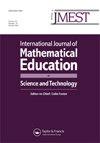Modelling labs for a course on differential equations
IF 0.6
Q3 EDUCATION & EDUCATIONAL RESEARCH
International Journal of Mathematical Education in Science and Technology
Pub Date : 2023-09-14
DOI:10.1080/0020739x.2023.2251480
引用次数: 0
Abstract
AbstractDifferential equations are widely used tools for modelling the world around us, making a course in differential equations a natural place for students to connect concrete mathematical applications to abstract concepts. Since students grasp the concepts better by applying them, introducing differential equations through modelling becomes essential. However, students often struggle to create and understand these models in the course. The purpose of this article is to share and examine a scaffolded sequence of labs implemented at regular intervals throughout a semester intended to train students in construction and analysis of mathematical models using differential equations. In these labs students learn basic principles of modelling that better prepare them for many of the high-quality modelling projects already available in differential equations. The course in which these activities were developed is taught using the SIMIODE text, Differential Equations: A Toolbox for Modelling the World, by Kurt Bryan. The labs are split into two components, with the first completed during class time and the second as out of class assignments. Furthermore, the course was re-organised to allow for the time needed to introduce the labs in class. We include classroom materials for labs, analysis, results on student perceptions and pedagogical recommendations.Keywords: Ordinary differential equationsmodellinglabspedagogyMathematics Subject Classification: 97M10 AcknowledgmentsWe would like to thank Alexandra Desaulniers for tirelessly working to support the creation and review of the labs. In addition, we thank Kurt Bryan for creating a textbook and many helpful resources to help us teach modelling in our differential equations course.Disclosure statementNo potential conflict of interest was reported by the authors.微分方程课程的建模实验
微分方程是被广泛使用的模拟我们周围世界的工具,因此微分方程课程是学生将具体的数学应用与抽象概念联系起来的自然场所。由于学生通过应用更好地掌握概念,因此通过建模引入微分方程变得至关重要。然而,在课程中,学生往往很难创建和理解这些模型。本文的目的是分享和检查在整个学期中定期实施的一系列实验,这些实验旨在训练学生使用微分方程构建和分析数学模型。在这些实验中,学生学习建模的基本原理,为他们在微分方程中已有的许多高质量建模项目做好准备。开发这些活动的课程使用SIMIODE文本,Kurt Bryan的微分方程:建模世界的工具箱。实验分为两个部分,第一部分在课堂上完成,第二部分作为课外作业。此外,课程被重新组织,以允许在课堂上介绍实验所需的时间。我们包括课堂材料的实验,分析,结果对学生的看法和教学建议。关键词:常微分方程建模实验室教学数学学科分类:97M10致谢我们要感谢Alexandra Desaulniers为支持实验室的创建和审查所做的不懈努力。此外,我们感谢Kurt Bryan创建了一本教科书和许多有用的资源,帮助我们在微分方程课程中教授建模。披露声明作者未报告潜在的利益冲突。
本文章由计算机程序翻译,如有差异,请以英文原文为准。
求助全文
约1分钟内获得全文
求助全文
来源期刊

International Journal of Mathematical Education in Science and Technology
EDUCATION & EDUCATIONAL RESEARCH-
CiteScore
3.30
自引率
11.10%
发文量
123
期刊介绍:
Mathematics is pervading every study and technique in our modern world, bringing ever more sharply into focus the responsibilities laid upon those whose task it is to teach it. Most prominent among these is the difficulty of presenting an interdisciplinary approach so that one professional group may benefit from the experience of others. The International Journal of Mathematical Education in Science and Technology provides a medium by which a wide range of experience in mathematical education can be presented, assimilated and eventually adapted to everyday needs in schools, colleges, polytechnics, universities, industry and commerce. Contributions will be welcomed from lecturers, teachers and users of mathematics at all levels on the contents of syllabuses and methods of presentation.
 求助内容:
求助内容: 应助结果提醒方式:
应助结果提醒方式:


